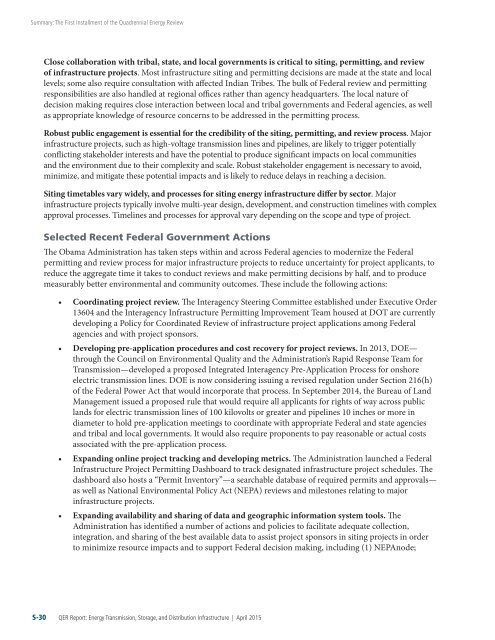LVXXU
LVXXU
LVXXU
You also want an ePaper? Increase the reach of your titles
YUMPU automatically turns print PDFs into web optimized ePapers that Google loves.
Summary: The First Installment of the Quadrennial Energy Review<br />
Close collaboration with tribal, state, and local governments is critical to siting, permitting, and review<br />
of infrastructure projects. Most infrastructure siting and permitting decisions are made at the state and local<br />
levels; some also require consultation with affected Indian Tribes. The bulk of Federal review and permitting<br />
responsibilities are also handled at regional offices rather than agency headquarters. The local nature of<br />
decision making requires close interaction between local and tribal governments and Federal agencies, as well<br />
as appropriate knowledge of resource concerns to be addressed in the permitting process.<br />
Robust public engagement is essential for the credibility of the siting, permitting, and review process. Major<br />
infrastructure projects, such as high-voltage transmission lines and pipelines, are likely to trigger potentially<br />
conflicting stakeholder interests and have the potential to produce significant impacts on local communities<br />
and the environment due to their complexity and scale. Robust stakeholder engagement is necessary to avoid,<br />
minimize, and mitigate these potential impacts and is likely to reduce delays in reaching a decision.<br />
Siting timetables vary widely, and processes for siting energy infrastructure differ by sector. Major<br />
infrastructure projects typically involve multi-year design, development, and construction timelines with complex<br />
approval processes. Timelines and processes for approval vary depending on the scope and type of project.<br />
Selected Recent Federal Government Actions<br />
The Obama Administration has taken steps within and across Federal agencies to modernize the Federal<br />
permitting and review process for major infrastructure projects to reduce uncertainty for project applicants, to<br />
reduce the aggregate time it takes to conduct reviews and make permitting decisions by half, and to produce<br />
measurably better environmental and community outcomes. These include the following actions:<br />
• Coordinating project review. The Interagency Steering Committee established under Executive Order<br />
13604 and the Interagency Infrastructure Permitting Improvement Team housed at DOT are currently<br />
developing a Policy for Coordinated Review of infrastructure project applications among Federal<br />
agencies and with project sponsors.<br />
• Developing pre-application procedures and cost recovery for project reviews. In 2013, DOE—<br />
through the Council on Environmental Quality and the Administration’s Rapid Response Team for<br />
Transmission—developed a proposed Integrated Interagency Pre-Application Process for onshore<br />
electric transmission lines. DOE is now considering issuing a revised regulation under Section 216(h)<br />
of the Federal Power Act that would incorporate that process. In September 2014, the Bureau of Land<br />
Management issued a proposed rule that would require all applicants for rights of way across public<br />
lands for electric transmission lines of 100 kilovolts or greater and pipelines 10 inches or more in<br />
diameter to hold pre-application meetings to coordinate with appropriate Federal and state agencies<br />
and tribal and local governments. It would also require proponents to pay reasonable or actual costs<br />
associated with the pre-application process.<br />
• Expanding online project tracking and developing metrics. The Administration launched a Federal<br />
Infrastructure Project Permitting Dashboard to track designated infrastructure project schedules. The<br />
dashboard also hosts a “Permit Inventory”—a searchable database of required permits and approvals—<br />
as well as National Environmental Policy Act (NEPA) reviews and milestones relating to major<br />
infrastructure projects.<br />
• Expanding availability and sharing of data and geographic information system tools. The<br />
Administration has identified a number of actions and policies to facilitate adequate collection,<br />
integration, and sharing of the best available data to assist project sponsors in siting projects in order<br />
to minimize resource impacts and to support Federal decision making, including (1) NEPAnode;<br />
S-30 QER Report: Energy Transmission, Storage, and Distribution Infrastructure | April 2015


